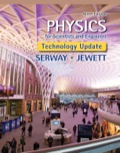
Concept explainers
(a)
The order of the samples from highest to lowest temperature.
(a)
Answer to Problem 20.1QQ
Explanation of Solution
Given info: The mass of each sample is
The specific heat of iron is
The formula to calculate energy is,
Here,
From equation (1), formula to calculate the change in the temperature is
Form equation (2), the change is temperature is inversely proportional to the specific heat. So larger the specific heat smaller is the change in temperature.
The specific heat of water is highest so the temperature change is the smallest. The specific heat of glass is less than water but greater than water so temperatures change in glass will be more than water but less than iron and the specific heat of iron is least so the temperature change in iron is most.
Conclusion:
Therefore, temperature order is
(b)
The rank of the samples from greatest to least amount of energy.
(b)
Answer to Problem 20.1QQ
Explanation of Solution
Given info: The mass of each sample is
The specific heat of iron is
The formula to calculate energy is,
Here,
Form equation (3), the energy of the sample is directly proportional to the specific heat of the sample as the mass of each sample and temperature change in the samples are same.
The higher is the specific heat higher the energy will be transferred into the sample for the given temperature increase. So the energy of water will be greatest as it has highest specific heat capacity then the energy of the glass as it has second highest specific heat capacity and then the energy will be least in iron as it has specific heat lowest.
Conclusion:
Therefore, the order from greatest to least energy transferred will be
Want to see more full solutions like this?
Chapter 20 Solutions
EBK PHYSICS FOR SCIENTISTS AND ENGINEER
- Lab 8 Part 3 PHET Wave Interface simulation. I am having trouble with this part of the lab.arrow_forwardMick and Rick are twins born on Earth in the year 2175. Rick grows up to be an Earth-bound robotics technician while Mick becomes an intergalactic astronaut. Mick leaves the Earth on his first space mission in the year 2200 and travels, according to his clock, for 10 years at a speed of 0.75c. Unfortunately, at this point in his journey, the structure of his ship undergoes mechanical breakdown and the ship explodes. How old is Rick when his brother dies?arrow_forwardHi, I have canceled, why did you charge me again?arrow_forward
 Principles of Physics: A Calculus-Based TextPhysicsISBN:9781133104261Author:Raymond A. Serway, John W. JewettPublisher:Cengage Learning
Principles of Physics: A Calculus-Based TextPhysicsISBN:9781133104261Author:Raymond A. Serway, John W. JewettPublisher:Cengage Learning Physics for Scientists and Engineers, Technology ...PhysicsISBN:9781305116399Author:Raymond A. Serway, John W. JewettPublisher:Cengage Learning
Physics for Scientists and Engineers, Technology ...PhysicsISBN:9781305116399Author:Raymond A. Serway, John W. JewettPublisher:Cengage Learning College PhysicsPhysicsISBN:9781285737027Author:Raymond A. Serway, Chris VuillePublisher:Cengage Learning
College PhysicsPhysicsISBN:9781285737027Author:Raymond A. Serway, Chris VuillePublisher:Cengage Learning Physics for Scientists and Engineers: Foundations...PhysicsISBN:9781133939146Author:Katz, Debora M.Publisher:Cengage Learning
Physics for Scientists and Engineers: Foundations...PhysicsISBN:9781133939146Author:Katz, Debora M.Publisher:Cengage Learning College PhysicsPhysicsISBN:9781305952300Author:Raymond A. Serway, Chris VuillePublisher:Cengage Learning
College PhysicsPhysicsISBN:9781305952300Author:Raymond A. Serway, Chris VuillePublisher:Cengage Learning An Introduction to Physical SciencePhysicsISBN:9781305079137Author:James Shipman, Jerry D. Wilson, Charles A. Higgins, Omar TorresPublisher:Cengage Learning
An Introduction to Physical SciencePhysicsISBN:9781305079137Author:James Shipman, Jerry D. Wilson, Charles A. Higgins, Omar TorresPublisher:Cengage Learning





